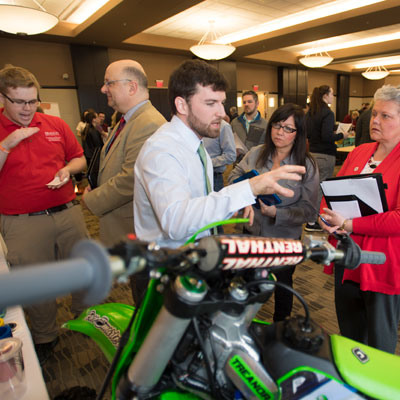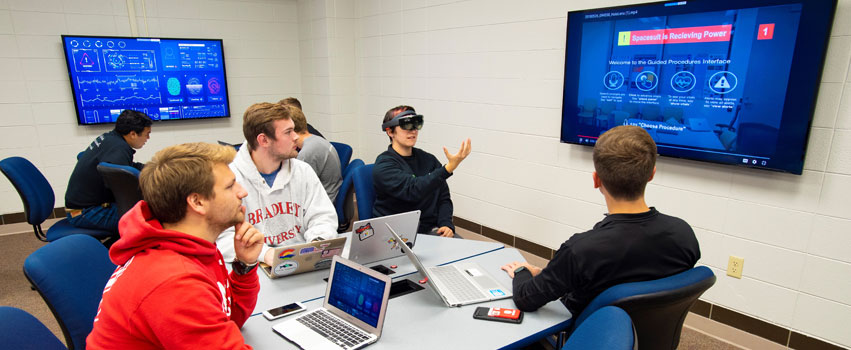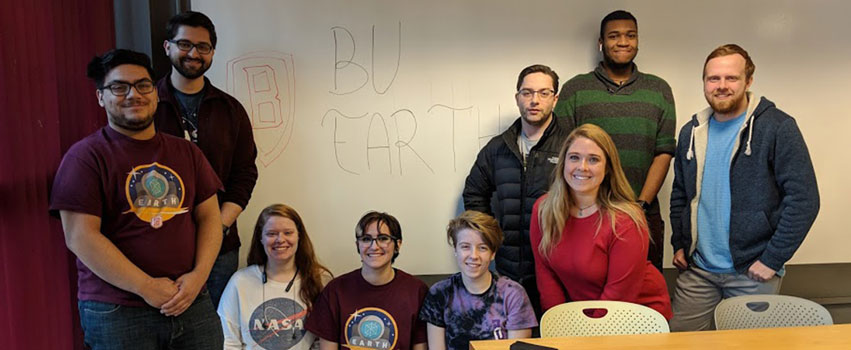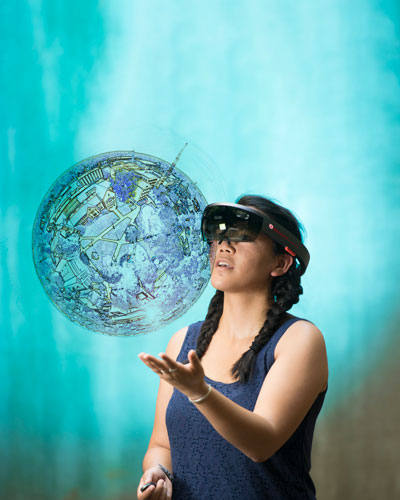Collaboration among groups and across disciplines aims to create a substantial impact around the region.
Bradley University was built on innovation and has always looked for ways to create innovative educational opportunities. Because it is a private institution, research with industry leaders has been welcomed at Bradley. These experiential education opportunities have been a key differentiator for its students. Over the last year, the university has been making great strides in a range of exciting, innovative initiatives across campus.
IDEA Factory
Started in August 2018, the IDEA Factory is a place where Bradley students can meet with a startup team, work on an idea, or network with other entrepreneurial-minded students. The Turner School of Entrepreneurship and Innovation established the IDEA Factory and secured a location for it on the second floor of the library on Bradley’s campus.
“This is our initial location,” explains Ken Klotz, managing director of the Turner School. “We are arranging a larger and more permanent location for the 2019-2020 academic year.” There are also plans to create a makerspace in the new facility, with access to students from across campus. The makerspace will provide tools and machinery for student entrepreneurs to create prototypes of products for testing market viability.
The primary goal of the IDEA Factory is to remove obstacles for student entrepreneurs. The incubator includes advising and mentorship, as well as college credit. “A student can earn up to 12 credit-hours over four semesters working on their own startup,” Klotz notes. In addition, the incubator plans to offer funding for startup ideas in the form of grants to take student-led projects to the next level. While the founders are college students, they will have access to these facilities. After graduation, they can be handed off to the NEST coworking space or the Peoria NEXT Innovation Center to continue the growth of the company.
Big Idea Competition
2018 was also the first year of the Big Idea Competition, organized by the Turner School of Entrepreneurship and Innovation, in which more than 100 students from all five colleges at Bradley competed for prize money totaling $20,000. This program will continue in 2019 with a similar amount of prize money. 
The Big Idea Competition is designed to allow students to develop an idea in a fun and competitive environment, with mentoring along the way. The 2019 competition starts with a two-page summary of an idea, due February 20, 2019. This summary will be judged by a panel, and the top 25 ideas will advance on to the “Tradeshow and Elevator Pitch” portion of the competition, scheduled for March 13, 2019—a great chance for the public to see ideas created by the students.
“What makes the Tradeshow unique is that everyone who visits is a judge,” adds Klotz, competition organizer. “Each visitor gets a ballot to vote for what idea they think is the best.” The student teams are also judged on an elevator pitch about their idea, and the two scores are combined to determine the top four finalists.
These finalists are mentored by members of the Illinois Small Business Development Center at Bradley to create a full business plan and pitch deck for the business idea. The finals are then judged by a panel of Bradley alumni based on the scores from the business plan and the final pitch. This determines the winner of the competition.
Convergence @ Bradley
Building on what Bradley has already established through convergence projects between the Foster College of Business and the Caterpillar College of Engineering & Technology, the plan is to expand and encourage such projects across campus—focusing on innovative and interdisciplinary projects with external sponsoring organizations.
“Bradley University has always had an innovative approach to educating their students,” says Bill McDowell, executive/academic director of the Turner School of Entrepreneurship and Innovation. “That was instilled by the founder, a female entrepreneur, in 1897.” This innovative approach can be seen in various ways, including opportunities to learn and work with students across multiple disciplines. Whether it is engineering and business students coming together to develop a new product idea, or nursing and computer science students analyzing dental records for the nursing profession, Bradley faculty understand how to collaborate.
“The key is to rethink how we educate our students,” McDowell notes. “The solutions of the past are not going to be the solutions of the future. This idea resonates with all our stakeholders, students, parents and our faculty.” These experiences will help to create new curriculum opportunities in the future—not only focused on business and engineering, but including disciplines from across the campus.
NASA Challenge
In 2017, Alanis Nash, an electrical and computer engineering student at Bradley, attended the Society of Women Engineers Conference. While visiting the NASA booth, she asked about applying for an internship, but was informed the agency didn’t offer internships. What they did offer, however, was the NASA SUITS (Spacesuit User Interface Technologies for Students) Design Challenge—a program to design, build and test an information display system for astronauts using augmented reality. Applications for the program were due late in 2017.

Developing spacesuit interfaces and experiences for NASA with the Microsoft HoloLens
From her involvement in First Robotics competitions in high school, Nash already understood that diversity helps drive innovation. She came back to Bradley’s campus with an idea to recruit a diverse team of individuals for the program. She found students majoring in English, computer science, communications, interactive media and engineering willing to contribute to this project without any college credit or compensation. Heather Ford, user experience program coordinator for the Department of Interactive Media, agreed to serve as lead faculty advisor.
In January 2018, the team learned their application was accepted. Then the hard work began. Using Microsoft’s HoloLens, they developed a system that would help astronauts conduct repairs on the International Space Station. “It is cool to think that something I worked on will be used in space,” Nash notes.
The week they presented their finished product to NASA and Microsoft, a NASA engineer told the group: “This is real engineering work… We need you to do this.” That really brought it home. “The students’ work ethic was amazing,” Ford comments. “They learned iteration [a cyclic process of design] and were excited about it. Everyone on the team bought in on the common goal.”
This year’s application was recently accepted by NASA, so Bradley students will again be working with the agency in 2019. With the help of inspiring professors like Heather Ford, Bradley University’s commitment to this competition will continue into the future.

This group of Bradley students will work with NASA on the second phase of the NASA SUITS Design Challenge in 2019.
Robotics Engineering Certificate
The Mechanical Engineering Department in Caterpillar’s College of Engineering & Technology is launching a Robotics Engineering Certificate Program in 2019. The certificate, offered through the Continuing Education Department, is focused on practicing engineers who are looking for a better understanding of designing for an autonomous environment. It will provide a solid foundation in the fundamental disciplines of robotics engineering, including basic and advanced robot concepts, machine vision, wireless communication systems and motion planning.
Dr. Sam Kherat is leading this effort for the university. With his past experience at Caterpillar—being involved in three DARPA autonomous vehicle challenges, leading the Caterpillar Automation Center near Carnegie Mellon University, and chairing multiple national and international conferences focused on autonomous safety—Dr. Kherat is an industry leader who brings extensive experience and unique perspective to students.
The new certificate program will be a tremendous opportunity for engineers already in the workforce. It will provide a deeper understanding of the autonomous solutions their own companies are initializing to understand how to support and maintain the machines that have been put in place. Participants will remain in the program for 12 months, which includes a capstone project defined by the student to benefit their company.
Brave Launch Extended
Brave Launch is a business accelerator program created by the Illinois Small Business Development Center (SBDC) at Bradley University. Based on the National Science Foundation’s I-Corps program, the seven-week initiative helps local startup companies gain an in-depth focus on their customers and the value chain of their product or service. With two cohorts of teams having gone through this experience, the question became: “What more can we do for these teams?” That is when Kevin Evans, director of the Illinois SBDC at Bradley, came up with the concept of Brave Launch Extended.
“After the intense seven weeks of Brave Launch, the teams still have to work to reach a place where the business or product idea would be ready for investors and ready to execute a viable business plan,” says Evans. This new program is intended to provide coworking space, additional structure to keep the teams striving for their goal, and mentors to provide advice along the way.
 It takes money to accomplish these goals, and we are delighted that area organizations have decided to sponsor Brave Launch Extended. UnityPoint Health – Methodist has agreed to be a platinum sponsor, with Migration Risk Management/Companion Life joining as a gold sponsor, allowing the teams to continue the journey of developing their idea and get the advice they need to reach success.
It takes money to accomplish these goals, and we are delighted that area organizations have decided to sponsor Brave Launch Extended. UnityPoint Health – Methodist has agreed to be a platinum sponsor, with Migration Risk Management/Companion Life joining as a gold sponsor, allowing the teams to continue the journey of developing their idea and get the advice they need to reach success.
“The important part is to challenge the teams to test their hypotheses and prove that the concept will win with customers—or they need to pivot,” Evans says. “Our goal is to help these teams understand the value they provide to customers.” By the program’s end, the entrepreneur will be ready for investment with a proven business model, or will be working on a different idea using the new tools they have learned through the process.
As you can see, innovation is being applied in a wide variety of areas at Bradley. The common theme is that collaboration among different groups will create a more substantial impact in the lives of students, faculty and businesses across the central Illinois region. iBi
Ross Miller is director of the Institute for Innovation Through Collaboration and director of technology commercialization at the Illinois Small Business Development Center at Bradley University.


